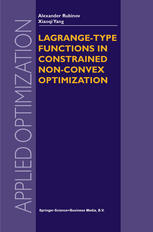

Most ebook files are in PDF format, so you can easily read them using various software such as Foxit Reader or directly on the Google Chrome browser.
Some ebook files are released by publishers in other formats such as .awz, .mobi, .epub, .fb2, etc. You may need to install specific software to read these formats on mobile/PC, such as Calibre.
Please read the tutorial at this link: https://ebookbell.com/faq
We offer FREE conversion to the popular formats you request; however, this may take some time. Therefore, right after payment, please email us, and we will try to provide the service as quickly as possible.
For some exceptional file formats or broken links (if any), please refrain from opening any disputes. Instead, email us first, and we will try to assist within a maximum of 6 hours.
EbookBell Team

4.4
102 reviewsLagrange and penalty function methods provide a powerful approach, both as a theoretical tool and a computational vehicle, for the study of constrained optimization problems. However, for a nonconvex constrained optimization problem, the classical Lagrange primal-dual method may fail to find a mini mum as a zero duality gap is not always guaranteed. A large penalty parameter is, in general, required for classical quadratic penalty functions in order that minima of penalty problems are a good approximation to those of the original constrained optimization problems. It is well-known that penaity functions with too large parameters cause an obstacle for numerical implementation. Thus the question arises how to generalize classical Lagrange and penalty functions, in order to obtain an appropriate scheme for reducing constrained optimiza tion problems to unconstrained ones that will be suitable for sufficiently broad classes of optimization problems from both the theoretical and computational viewpoints. Some approaches for such a scheme are studied in this book. One of them is as follows: an unconstrained problem is constructed, where the objective function is a convolution of the objective and constraint functions of the original problem. While a linear convolution leads to a classical Lagrange function, different kinds of nonlinear convolutions lead to interesting generalizations. We shall call functions that appear as a convolution of the objective function and the constraint functions, Lagrange-type functions.